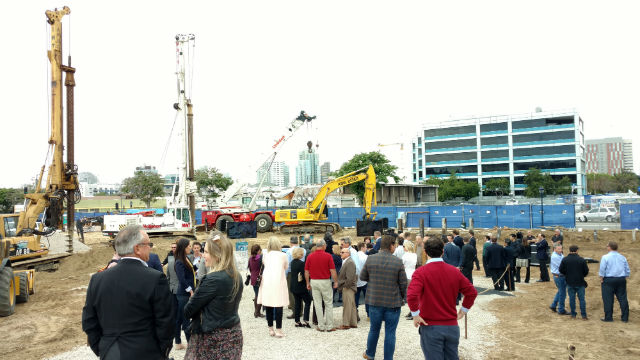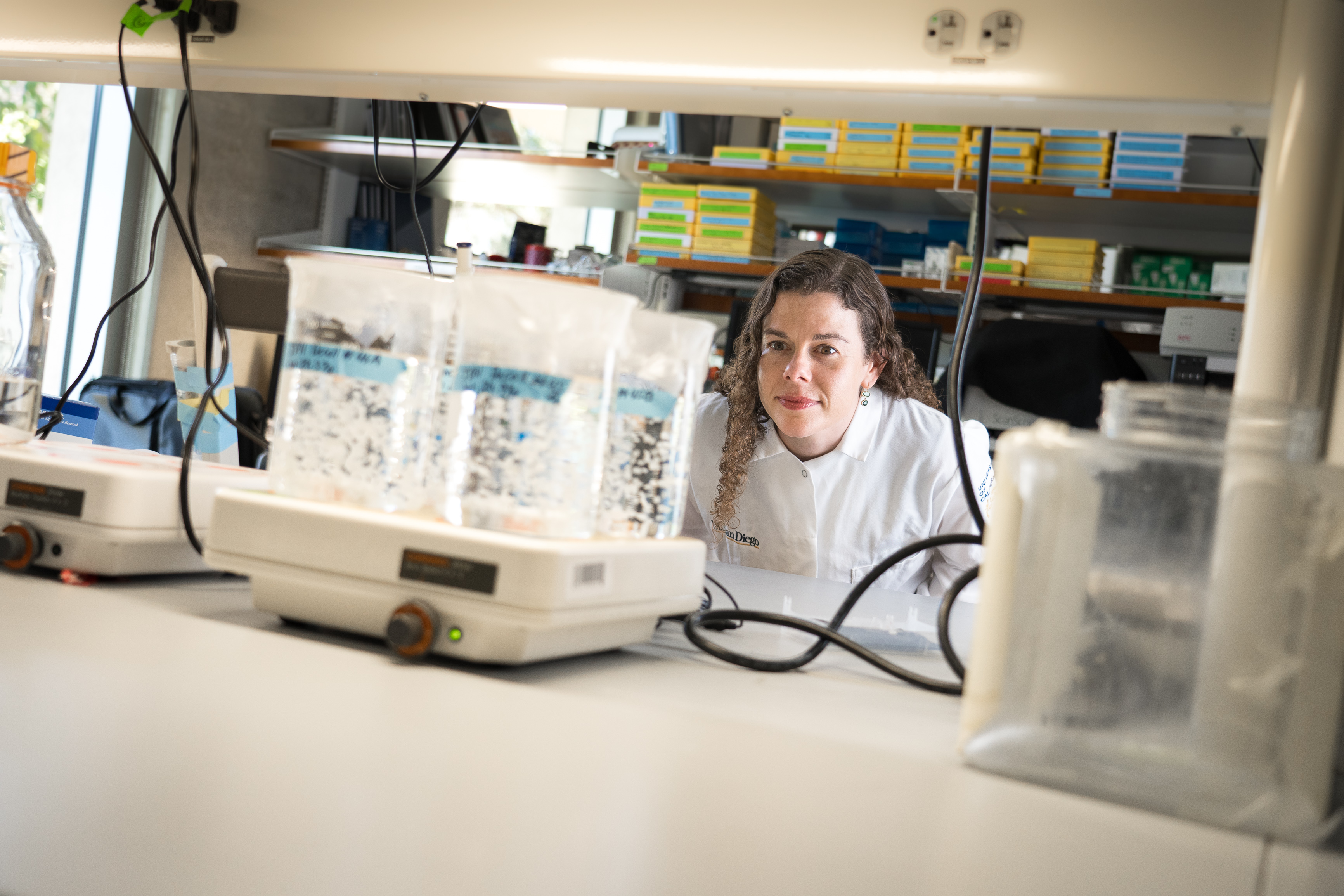Daily Business Report-April 12, 2016
The crowd gathered at the construction site for the official groundbreaking. (Photo by Chris Jennewein)
Developer Begins First New
Building in Makers Quarter
By The Times of San Diego
The developer of the six-block Makers Quarter artists and entrepreneurs in downtown San Diego officially broke ground Monday for the first new building.
“We need places like Makers Quarter to ensure we have a home for ideas,” said Mayor Kevin Faulconer at the groundbreaking. “Great things are happening in San Diego and people around the country are recognizing it.”
The Broadstone Makers Quarter project at 16th and Broadway will include 265 residential units and nearly 5,000 square feet of retail space along Broadway in the East Village area.
The developer is Alliance Residential Company, a Phoenix-based real estate company specializing in muli-use communities.
“Since day one, the Alliance team have been believers wholeheartedly in the promise of the Makers Quarter,” said Brandon Nichols, development director for Alliance.
Upon completion, the Makers Quarter neighborhood will include one million square feet of office space, approximately 800 residential units, 175,000 square feet of retail shops and restaurants and 60,000 square feet of open public space, parks and public art.
“It is the first groundbreaking of Makers Quarter with many more to come ” said Stacey Pennington, urban planner for the Makers Quarter.
She said the new building is especially notable because it is at the eastern edge of downtown and will serve as a gateway on Broadway.
The neighborhood is already home to two popular outdoor community venues, SILO and SMARTS Farm, as well as the FAB LAB San Diego public workshop, the Urban Discovery Academy and Fuse Integration. Developers envision a creative environment that inspires entrepreneurs and artists.
The long term plan envisions new construction and renovation of six blocks south of the San Diego City College campus.
_____________________________________________
First Forum is Tonight for
San Diego Mayoral Candidates
By City News Service
The first of three forums for San Diego mayoral candidates is scheduled for tonight at 6 o’clock.
Mayor Kevin Faulconer, lifeguard union chief Ed Harris and ex-legislator Lori Saldana will take part in the forum hosted by Univision/Telemundo.
The other forums will be held on May 24, hosted by KUSI and the San Diego Union- Tribune, and on June 3, hosted by NBC7/39 and the Voice of San Diego.
Faulconer is finishing the term of Bob Filner, who resigned in August 2013 after nearly 20 women stepped forward to accuse him of sexual harassment. He took office after winning a special election in February 2014.
Harris succeeded Faulconer on the City Council and served eight months in an interim role after pledging not to run for the seat in the 2014 election.
Saldana served in the Assembly from 2004-2010 as a Democrat, but left the party two years ago following disputes with local leaders and a growing antipathy for party politics.
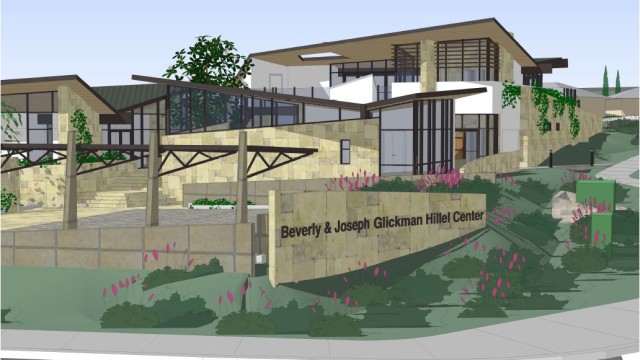
$5 Million Gift Will Help Build
Hillel House Near UCSD
By the Times of San Diego
Hillel of San Diego announced Sunday a $5 million gift to build its proposed Hillel Center for Jewish Life near the UC San Diego campus.
The gift from Joseph “Chickie” Glickman was announced at the Hillel’s Campus SuperStar fundraising event at the Irwin M. Jacobs Qualcomm Hall.
“Hillel is the answer to one of the most important challenges of our time,” said Elaine Galinson, Glickman’s daughter. “At a time when young people are setting patterns for their adult lives, Hillel offers sophisticated, compelling programs to help ensure that the next generation embraces and renews the Jewish values and traditions that will guide them as they become the leaders of tomorrow.”
“We are extremely grateful for this generous gift,” said Rabbi David Singer, director of UC San Diego Hillel. “The Glickman Hillel Center will be the convening space for Jewish life on campus, and is the remaining critical piece we need to make sure that all students are welcomed into the community and have a platform for developing as leaders and thriving as Jews.”
The Beverly & Joseph Glickman Hillel Center is nearing the end of the City of San Diego’s planning review process and will soon be before the City Council for approval.
The site is a vacant, triangular parcel at Torrey Pines Road and La Jolla Village Drive, near the La Jolla Playhouse and J. Craig Venter Institute. The project has faced numerous political and legal hurdles over its 15-year-history, with neighbors raising concerns about traffic and parking.
A similar Hillel centet opened two years ago on the San Diego State University campus near the KPBS studios.
At the SuperStar event Sunday, ten college students from a diversity of backgrounds performed in an American Idol-style competition for $7,500 in prizes. The winner was Jazmine Rogers from MiraCosta College.
Hillel encourages students of all backgrounds to form deep, personal connections to Jewish life, learning and Israel, empowering student leaders with the creative directorship to build community on their own terms.
Ballot Measure to Raise Funds
For Fire Stations Advances
By City News Service
A proposed ballot measure to raise bond funds for fire station construction in San Diego was forwarded to the City Council Monday by the Rules Committee, though questions remain about details of the plan.
If passed by voters in the November general election, two bonds totaling $205 million would fund construction of nearly 20 fire stations designed to fill geographical gaps where response times are longer than the standard of 7 minutes, 30 seconds.
Because the bond would raise property taxes, two-thirds voter approval would be necessary for passage.
According to Councilwoman Marti Emerald, who has been meeting with community groups around San Diego in recent months to drum up support for the proposal, the average homeowner would pay $5 for every $100,000 in assessed value. That’s around $25 a year, she said, calling it “a real value for greater public safety going forward here in San Diego.”
A consultant found in 2010 that San Diego was in need of 19 new fire stations, of which 10 were considered critical.
The city has since opened a station in Mission Valley, started construction for another in Little Italy, and has obtained developer funding for three more — in Black Mountain Ranch, the South Bay and University City.
The priorities and locations of the rest might not be available to San Diegans by the time they cast their votes, however. The Folsom-based consultant, Citygate, has been rehired by the San Diego Fire-Rescue Department for nearly $102,000 to provide an update, which isn’t scheduled for completion until October.
San Diego fire department Chief Brian Fennessy said unsynchronized clocks led to erroneously reported response times in the 2010 Citygate study, and new data could result in a shift in the service gaps. Citygate also has access to better technology, including maps on how traffic congestion affects response times, he said.
“I expect there will be differences in the outcome,” Fennessy said. The changes likely won’t be huge, but could revise planned locations, priorities or even the number of stations needed, he said.
Since the new data would be received so close to the election, city officials wouldn’t be able to provide the information to voters on the ballot.
Emerald asked that the committee pass along her planned measure so the full City Council can direct the City Attorney’s Office to draft ballot language. The action passed 3-2, with Councilmen Chris Cate and Mark Kersey dissenting.
According to Emerald, the city is building a fire station every five years. At that rate, it would take nearly a century to complete the number currently needed. Funding from her bond measure would allow the stations to be built in a decade.
Higgs Fletcher & Mack Awards
Fourth Diversity Scholarship
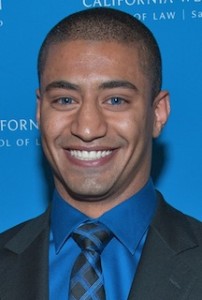
Higgs Fletcher & Mack has awarded its fourth $4,500 California Western School of Law Diversity Scholarship to Beshoy F. Shehata. A 2017 Juris Doctor candidate, Shehata was selected for demonstrating ethical and civic leadership and for providing services to underrepresented groups in the community.
Shehata grew up in Cairo Egypt and at age 10, his family moved to the U.S. to avoid religious persecution. When he first arrived, Shehata had minimal knowledge of the English language, which made learning difficult. However, he has successfully become the first college graduate in his family. Law has always been Shehata’s passion. Because of his background, his goals are to protect the public and advocate for the weak. Shehata received his Bachelor of Arts in Liberal Studies and International Peace Studies from University of California Santa Barbara.
“At Higgs, we have a commitment to education and promoting diversity throughout the legal community. The firm has always been a trailblazer in diversity efforts and Beshoy is more than deserving of this award,” said Rahil Swigart, member of the Higgs Fletcher & Mack Diversity Committee and California Western School of Law alum. “This is our fourth year providing the scholarship to California Western and it wouldn’t be possible without the numerous attorneys at the firm who contributed.”
The Higgs Fletcher & Mack attorneys that participated in funding this year’s California Western School of Law scholarship include: Roger Clayton, Steve Cologne, Gerissa Conforti, Brian Cook, Mitchell Dubick, James Eischen, Thomas Ferrell, Loren Feestone, Joseph Gonnella, Susan Hack, James Harrigan, Craig Higgs, Scott Ingold, Rachel James, Joseph Kagan, Regina Knoll, Kathryn Martin, Susan Mercure, Rachel Moffitt, John Morrell, John Nielsen, Stephen Pelletier, Rahil Swigart and Timothy Waters.
Nonprofit Leadership Veteran
Takes Over San Diego Coastkeeper
Tracie Barham, an 18-year veteran of nonprofit leadership, has been named the new executive director of San Diego Coastkeeper.
Barham will lead the water watchdog’s efforts to achieve goals in its 2015-2018 strategic plan,which include lowering San Diego County household water use by 25 percent and training 300 new volunteer scientists to monitor the health of the region’s watersheds.
Travis Pritchard, who served as interim executive director, returns to his role as program director.
Barham comes to San Diego Coastkeeper from her position as director of development for the San Diego Botanic Garden. As the chief development officer, Barham significantly increased overall operating and capital income to fund the launch of several expansion projects. As a graduate of the Fieldstone Emerging Leaders program, Barham worked closely with the San Diego Botanic Garden board of directors, CEO, and other senior leadership team members to raise the philanthropic support needed while contributing to the strategy and operations of these projects.
City Attorney Says Briggs/Frye
Initiative Puts City at Risk
City Attorney Jan Goldsmith today released a comprehensive review of the “Citizens’ Plan,” a ballot initiative proposed by attorney Cory Briggs and former Councilmember Donna Frye. The review was requested by Mayor Kevin Faulconer and was provided to the Mayor and City Council.
The report with 153 footnotes explains the proposed Initiative and identifies a number of potential legal problems posing a legal risk to the City of San Diego.
In explaining the Initiative, the Report dispels several myths surrounding the Briggs/Frye Initiative. For example, some have stated that the Initiative “clears the environmental hurdles” for a downtown convadium. The Initiative does not clear environmental hurdles for any downtown project. Rather, it establishes a local environmental process, with questionable legality, setting forth requirements that equal or exceed the current environmental requirements in state law. (See Report, page 9, “CEQA Exemption and Environmental Mandates for Overlay Zone Projects”).
Legality issues are discussed in Section I of the Report which states as follows:
“Part 6 of the Briggs/Frye Initiative, “Interdependence; Interpretation,” states that all of the codified provisions,[1] discussed below, are “inseparably interconnected and interdependent” such that if “any portion” of the codified sections “is held to be invalid by a court of competent jurisdiction after any and all appeals are complete, then none of the remaining portions of the Ordinance shall have any force or effect.”
This provision voids the entire Initiative if any substantive provision is successfully challenged in court. It operates as a “poison pill” by eliminating the entire Initiative upon one provision being held invalid.
This is a very unusual provision. An initiative would typically state just the opposite to ensure that all of its terms are not jeopardized by one legal issue. By including this “poison pill” in the Briggs/Frye Initiative—a complicated and varied initiative containing some legally questionable terms—the authors have rendered the measure legally unreliable.
This Report identifies six provisions that are arguably invalid, any one of which, if found invalid, would invalidate the entire initiative:
• Allowing hotel operators to retain tax revenue collected from guests (who are the taxpayers) is at odds with state and local laws, including San Diego Charter section 85, requiring deposit of all tax revenue in the City’s treasury. See Part IV.C and D
• Allowing hotel operators to exercise discretion in deciding whether to fund certain outside agencies may be at odds with Charter section 11.1, which prohibits delegation of the City Council’s legislative discretion to third parties. See Part IV.D
• Creating a new “Downtown Convention and Entertainment Overlay Zone” (Overlay Zone) in the City in which CEQA does not apply to certain types of development and replacing CEQA with a local environmental law goes well beyond current law, including recent California Supreme Court decisions. This could result in a legal challenge and “test” case. See Part III
• Requiring “any project” authorized under the new downtown Overlay Zone to pay $15 million to the Port District and $5 million for a Mission Valley reserve fund may be challenged on constitutional grounds. See page 6, fn 16 and page 10 fn. 41
• Directing the San Diego Unified Port District (Port District), a separate government agency, on the use and expenditure of certain funds may infringe on the Port District’s jurisdiction under state law. See page 7, fn. 17 and fn. 18.
• Including various provisions in the Initiative to increase taxes, create new downtown zoning (Overlay Zone), prohibit expansion of the convention center on its current site, authorize sale and set conditions for development of the Qualcomm Stadium site in Mission Valley, create a new environmental law to replace CEQA in the Overlay Zone, direct use of Port District funds, create an environmental reserve fund for Mission Valley, and address the land use needs of San Diego State University and other educational institutions creates a strong likelihood that the Initiative violates the constitutional requirement that initiatives be limited to a single subject. See Part VII.
This unusual “poison pill” provision creates financial risks for the City in the event of litigation. For example, because our office questioned the legality of the original convention center tax increase designed by outside tax counsel, we insisted that no tax be collected until final court approval on a validation action we would file. When the tax was found illegal years later, the City was not ordered to pay refunds as no taxes were collected.
This Initiative similarly contains legally questionable provisions, any one of which could invalid the entire Initiative, including the tax increase. Litigation challenging the measure could take many years to conclude during which the measure requires that the new taxes be collected. The Initiative contains no protection or security for the City from having to repay taxes or rescind actions upon a court finding one provision invalid, thereby rendering the entire Initiative void.
Does the Brain Hold the Key
To Burning More Fat?
Food intake is known as an important regulator of metabolism. For example, if consumption of food is low, the body burns fat and makes up for missing nutrients. But there’s growing evidence that fat burning is more complicated than previously thought.
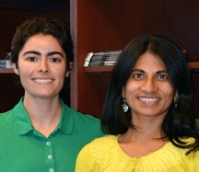
A new TSRI study on a roundworm called C. elegans is the first to show that cues picked up from the environment – specifically, the sensing of oxygen by the brain – determined how quickly their intestines burned fat.
Surprisingly, this communication worked both ways, and fat reserves in the intestine could also influence the strength of the fat-burning signal from the nervous system.
“The implications for this are interesting,” said TSRI Assistant Professor Supriya Srinivasan, who was senior author of the new study. “If oxygen-sensing neurons change their activity based on how much fat there is in an animal, what other neuronal functions can fat modulate?”
The findings raise the possibility of a similar mechanism in humans that may be dysregulated in diseases such as Bardet-Biedl Syndrome, in which patients with extreme obesity appear to have dysfunctional sensory perception. However, the oxygen sensors in humans are not yet known.
Recent research has also shown that the nervous system circuits involved in regulating metabolism are distinct from those regulated by feeding behavior.
“That implies that our metabolism is not a simple consequence of food intake,” said Srinivasan.
But if food intake isn’t the only player in controlling metabolism, what else is?
In the new study, the researchers screened a family of genes known to be important in sensory perception. By deleting these genes one at a time in C. elegans, the researchers found that two of these genes were connected to fat metabolism. Interestingly, one of the genes was only expressed in a handful of neurons previously shown to sense oxygen levels in a worm’s environment.
“A lightbulb went off in my head — there could be a connection between sensing oxygen and burning fat,” said Srinivasan.
Using genetically encoded fluorescent sensors, the researchers found that the amount of fat reserves could affect neuronal activity in response to oxygen.
The researchers believe this connection in C. elegans might exist as a way of sensing food availability. The worms eat bacteria that consume oxygen, so slightly lower levels of oxygen, compared with normal atmospheric oxygen, signal that a meal is nearby.
In a follow-up experiment, the researchers found that when oxygen levels were high – indicating no nearby food — the worms would ramp up fat burning. It was as if these worms switched to emergency mode and broke open the reserve rations.
When oxygen levels were slightly lower — indicating nearby food – the worms didn’t burn fat as quickly. The worms seemed to sense a meal was coming, so there was no need to switch to emergency fat-burning mode yet.
To their surprise, the researchers found the intestine can also communicate back to the neurons. When fat reserves dipped too low, the neuronal signal to burn fat was dampened. This led the researchers to predict that the intestine was signaling the neurons to lower their activity when there wasn’t enough fat available to be burned.
While it’s too soon to say if the insights on fat burning translate to humans, the findings may open new doors to research on metabolism and the mysteries of cross-tissue communication. The next step in this research is to identify the molecule that delivers the messages between the intestines and the neurons at play in this study.
“We think a hormone-like factor is secreted,” said Srinivasan. “We’re chasing down that signal.”

